Flora and fauna
Langøya has for a long time been known in botanical circles for its rich flora. Particularly interesting is that the flora on the island was studied extensively back in 1826 by Professor M. N. Blytt. An account of the study was published, and a complete list of species from Langøya can be found at the Botanical Museum in Oslo. What flora and fauna thrive in Langøya today?
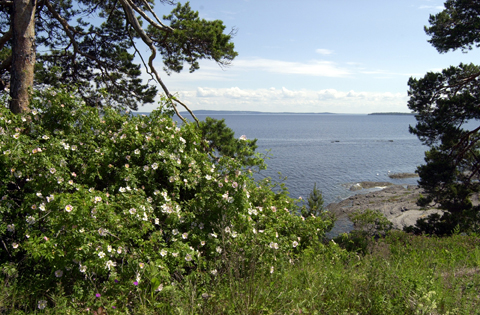 It is the bedrock on Langøya that makes the flora and fauna of the island so rich. The limestone on Langøya contains chalk and other alkaline minerals that different plant species are more or less dependent on. The limestone feeds plants that fail to grow on acidic rocks, such as bedrock areas in Norway. The mineral-rich bedrock on Langøya also provides microorganisms, which break down dead plant material, and good growing conditions. On more nutrient-poor bedrock the dead material forms a sizeable layer of humus. Common humus-dependent species, such as heather and bilberry, are therefore rare on Langøya. However, the lack of humus means that no soils develop, which in dry periods can store moisture from rain. Plant species that will thrive in Langøya must therefore be able to withstand very dry growing conditions.
It is the bedrock on Langøya that makes the flora and fauna of the island so rich. The limestone on Langøya contains chalk and other alkaline minerals that different plant species are more or less dependent on. The limestone feeds plants that fail to grow on acidic rocks, such as bedrock areas in Norway. The mineral-rich bedrock on Langøya also provides microorganisms, which break down dead plant material, and good growing conditions. On more nutrient-poor bedrock the dead material forms a sizeable layer of humus. Common humus-dependent species, such as heather and bilberry, are therefore rare on Langøya. However, the lack of humus means that no soils develop, which in dry periods can store moisture from rain. Plant species that will thrive in Langøya must therefore be able to withstand very dry growing conditions.
There are still areas of the island with greater soil depth. This is due to the significant uplift that has taken place in the Oslo Fjord area since the last ice age: Until about 5500 years ago Langøya was entirely under water. As the island rose from the sea, the sand and mud washed down from what today appears as knolls, while the thicker layers of soil in former coves and hollows were left behind. In areas such as Langøya, the vegetation is fresher (and more moisture-independent). It is these areas that in the past gave rise to farming on the island.
The phenomenon of rising land on Langøya is also interesting from another perspective: It tells us about the age of Langøya’s flora. From this we know that all species found on the island during the 5500 years since the island emerged from the sea.
Langøya has, by Norwegian standards, a very favourable climate. The summers are long and hot and the winters are mild. Thus, we find many species here that normally grow in southern Norway. Mistletoe is a good example of this.
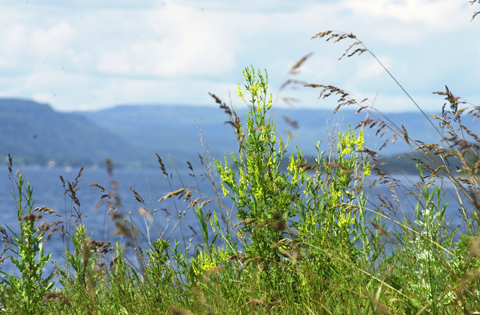 Clear traces of former agricultural activities are still visible on Langøya. The landscape on the north of the island was previously more open than today, and after farming of the land ended, the areas here became overgrown with lush forest consisting of many different deciduous trees and spruce and pine. Open, flowery meadows still grow here from when farms fell into disuse. You can still find old garden crops such as apple trees, hesperis matronalis and narcissus.
Clear traces of former agricultural activities are still visible on Langøya. The landscape on the north of the island was previously more open than today, and after farming of the land ended, the areas here became overgrown with lush forest consisting of many different deciduous trees and spruce and pine. Open, flowery meadows still grow here from when farms fell into disuse. You can still find old garden crops such as apple trees, hesperis matronalis and narcissus.
An interesting phenomenon is that the old open pits north of the island today have grown again. They are covered now by a short pine forest with a very interesting flora growing on the forest bed. Here you can find the orchid fly flower. This is one of Langøya’s most important botanical attractions.
The fauna on Langøya
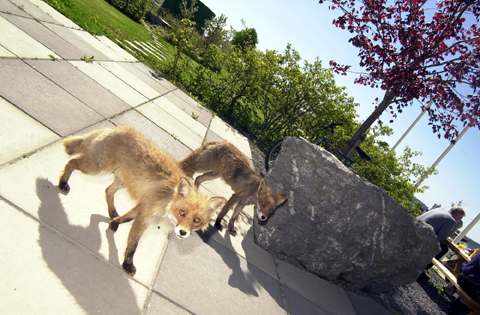 This part of the Oslo Fjord was rarely visited by entomologists. The most popular island was Tofteholmen, which was visited by insect collectors back in the 1800s. In 1953 a trip was organised there for the ninth Nordic entomologist meeting. However the trip was cancelled as it appeared Langøya wasn’t popular enough.
This part of the Oslo Fjord was rarely visited by entomologists. The most popular island was Tofteholmen, which was visited by insect collectors back in the 1800s. In 1953 a trip was organised there for the ninth Nordic entomologist meeting. However the trip was cancelled as it appeared Langøya wasn’t popular enough.
To find out more about the insects on Langøya you either need to refer to literature written on the subject or through older insect collections. The Zoological Museum in Oslo contains Norway’s largest insect collection. Here you meticulously prepared insects dating right back to the 1800s. Each insect has a label of where it was found, and also the date and name of the collector. The material in the museums can be used for research. Here you can read about the changes in insect fauna over the years. Some species are becoming extinct, while new ones are also appearing. You can also find out who gathered what and when.
One of Norway’s largest entomologists was beetle researcher Thomas G. Münster (1855-1938). He travelled around the country collecting beetles. In collections at the Zoological Museum in Oslo you can see that he visited Langøya several times in the 1920s. However, his collections were relatively small. It is only after 1987 that the insect fauna from Langøya was thoroughly investigated, and nearly 2 000 species have now been found. Most of this material can be found in the collections at the Zoological Museums in Oslo and Bergen.
Digger wasp and fly flower
There are only a few places in Norway where the peculiar fly flower is as common as it is on Langøya. Here it grows in abundance. The interaction between this orchid and the digger wasp, the Argogorytes mystaceus, is probably one of the most amazing our northern nature can produce. Orchid flowers have developed a particularly clever way to lure the poor digger wasps so that they aid
pollination. Orchids do not offer nectar or pollen as flowers do. But they do provide tempting ’females’. They don’t exactly resemble the female digger wasp, but they do smell like them and this seems to be enough. Experiments conducted in Sweden showed that males were more attracted to the flowers than the real females. Probably because the flowers smell stronger and have stronger colours than the females.When a male land on a flower to mate with it, one or two pollinates (pistils) stick to the wasp. The wasp then carries these with it and will then pollinate any flower it visits afterwards.
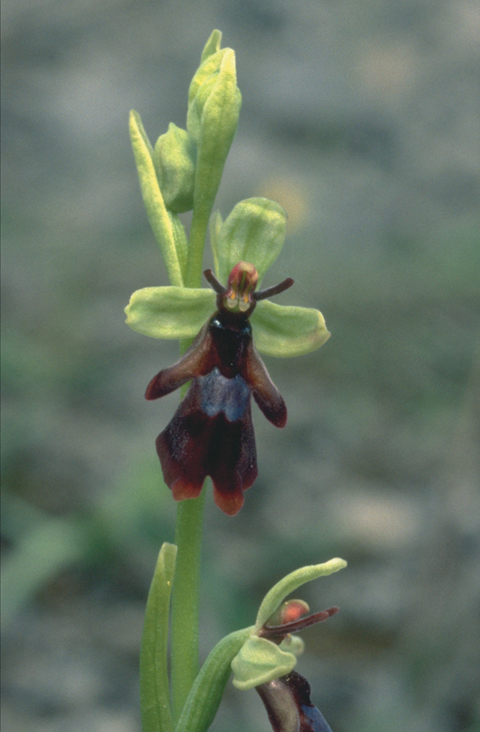 Digger wasps are relatively common on Langøya, while the related sibling, the Argogorytes fargei, also lured by the fly flower, is considerably rarer. The fly flower is dependent on these wasps for them to be pollinated. Wasps however manage well without the plant, and can therefore be found far beyond the fly flower’s distribution area.
Digger wasps are relatively common on Langøya, while the related sibling, the Argogorytes fargei, also lured by the fly flower, is considerably rarer. The fly flower is dependent on these wasps for them to be pollinated. Wasps however manage well without the plant, and can therefore be found far beyond the fly flower’s distribution area.
The phenomenon of fly flowers luring male wasps to “mate” with it is very common in the tropics. Species of other wasp families are also fooled. Such interaction usually only occurs between one species of orchid and one or very few wasp species. This is because an orchid is only capable of producing one scent.
The digger wasps from the Mystaceus gene is the predatory wasp that feeds on cicadas. The female wasps catch these insects and bring them “home” to a clever pathway system on the ground. Here cells are put in place to fill up with paralyzed cicadas. These cells act as larval chambers. Each cicada is paralyzed with a
small sting. When the cell is filled up with cicadas, the wasp adds an egg and seals the cell. Here the larva has enough food to grow. It hatches in early summer. If it is a male, it flies out to hunt fly flowers and female wasps. Much research has been conducted on digger wasps. They are not true social wasps, but their communities have certain degrees of sociality. For example, closely related females help each other to fill the larva chambers. Here one can sense the evolutionary transition from a solitary wasp, via various primitive forms of sociality and the real social wasps such as ant wasps and bumblebees. These in turn have their own work castes that are entirely dedicated to the community and which never get any opportunity to mate.
Flower meadows that glitter like gold
If you go ashore on Langøya on a warm midsummer’s night, if you’re lucky you might see hundreds of tiny twinkling lights, almost like tiny gold nuggets that sparkle in the grass. These are glowworms. They are not worms exactly but females of a particular species of beetle – the Lampyra noctiluca. This belongs to the light beetle family, and in Norway we only have this one representative of the family. At the back of the abdomen, this wingless and highly inconspicuous female beetle has a small light organ. There are special cells containing the
Luciferin substance. When this is affected by the enzyme luciferase and water, oxidation occurs and energy is released. Almost 95% of this energy is released as light. By comparison, the sun releases only 35% of energy as light. Adjacent to the light cells are uric acid crystals that act as reflectors of light rays. Luciferin is also used in medical research, where it has replaced radioactive markers such as radioactive iodine, with illuminated displays instead. Luciferin has thus been used as a marker of insulin, myoglobulin and thyroid hormone. This is a textbook example of how important it is to preserve the biodiversity of nature. We never know what we might need later.
The female beetle uses light to lure males. These have developed wings, and they swarm the flower meadows looking for bright females. The midsummer worm is the only species of this family in Norway, but the tropics contains a plethora of species, many of which have females with fully developed wings. These are called glowworms – which is just as misleading as to call the Norwegian species a worm – both are beetles. The midsummer worm is very common on Langøya and can be seen in their hundreds on Midsummer’s Eve. They are found on Østlandetand and occur most frequently in the Oslo Fjord area.
The discerning butterfly
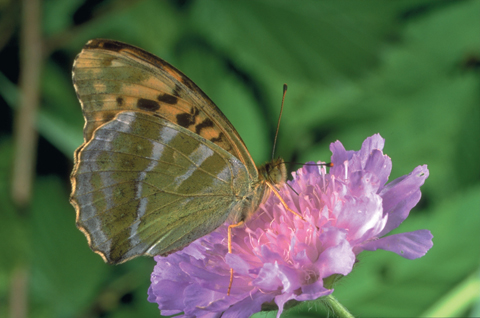 Butterfly fauna on Langøya is unique, on a national level. Almost 600 species have so far been detected here, and several of these are very rare. Many species thrive where it is hot, hence on Langøya. However, the main cause of this diversity is probably that well over half of our 2109 butterfly species is only related to one or very few plant species. As Langøya is known for its rich flora, they naturally go together. Important in this context are both the lime soil and the island’s favourable climate. Two very interesting plant species that should be mentioned in this context are field wormwood and genuine mugwort. Both of these are common on Langøya. More than ten different small butterfly species are related to field wormwood while fewer are related to the mugwort. Several of these butterflies are very rare and they will not be able
Butterfly fauna on Langøya is unique, on a national level. Almost 600 species have so far been detected here, and several of these are very rare. Many species thrive where it is hot, hence on Langøya. However, the main cause of this diversity is probably that well over half of our 2109 butterfly species is only related to one or very few plant species. As Langøya is known for its rich flora, they naturally go together. Important in this context are both the lime soil and the island’s favourable climate. Two very interesting plant species that should be mentioned in this context are field wormwood and genuine mugwort. Both of these are common on Langøya. More than ten different small butterfly species are related to field wormwood while fewer are related to the mugwort. Several of these butterflies are very rare and they will not be able
survive where host plants do not grow. Another interesting species is the astragalus glycyphyllos, which has two species of moth sack, which only like this plant. Inula Salicina Plume Moths is another characteristic small butterfly on Langøya. The larvae develop solely on Inula salicina, and the butterfly is only detected in very few Oslo fjord localities. The species is listed on the National Register of endangered species.
There is hardly a herb, a shrub or a tree species that do not have one or more butterfly species associated with them. Species that are associated with rare plants are of course dependent on plant life. If one plant species disappears, this could again lead to more insect species disappearing simultaneously. In some cases also the area the plant grows also has to be right. Krushøymol Sack Moths are only related to the krushøymol plant, yet
exists only where the plant grows exposed on beaches. The butterfly does not therefore follow the plant inland, and the presence of a plant does not mean that the corresponding butterfly will be found there.
Of the many beautiful butterflies, some are extra eye-catching and beautiful. One such species is the argynnis paphia. It is relatively uncommon so far north, but thrives on the islands in the outer Oslo fjord. A few species are encountered north of Oslo, but most are happiest in the south. The larvae develop solely on violets, and eggs are laid in late summer on violet fauna, especially viola riviniana. The tiny larvae hibernate, often in a crack in the bark of the nearest tree. As soon violet leaves start shooting in spring, they start eating. Growth then continues to the pupa stage. Inside the pupa all the larval organs are broken down and the beautiful butterfly is formed. In summer the pupa cracks, and a dishevelled figure appears. The wings are inflated and dried, and the very next day the butterfly is ready for its first flight.
Many of the night butterflies are also very beautiful. Unfortunately these are not usually spotted due to their only nightly appearance. During the day they sit tucked away in the vegetation, or their pattern makes them blend into the background.
One of the loveliest butterflies is the Plagodis dolabraria. This is a relatively unusual type, prevalent in Southeast Norway. It has only been spotted once on Langøya, but is relatively common in neighbouring Mølen.
Unique insect fauna
About 20 parasitic wasp species in Norway have been found solely on this unique island.
Most of these species are known from Central Europe or Russia. The dance fly Platypalpus norvegicus can also be spotted. This was named after some specimens caught on Ostøya in Bærum. The Latin name says that it is from Norway. It was later discovered in a few other localities in the Oslo Fjord area, including Langøya, but has not yet been spotted beyond our borders.
Beetles
Beetle fauna on Langøya also boasts several peculiar species. The small leaf Chargers Aphtona pallida in Northern Europe has only been identified here. Larvae attaches itself to cranesbill, probably blood cranesbill. This species is listed on the National Register of endangered species.
Flies
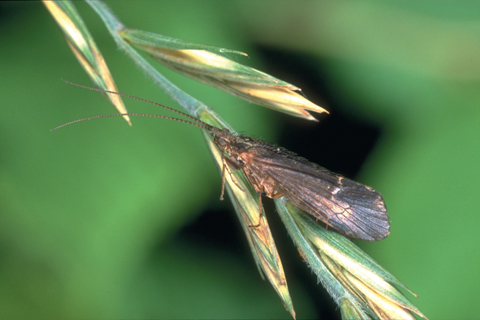 That a dry island like Langøya also shelters freshwater insects is perhaps somewhat surprising. But all it takes is a few small streams and puddles for certain species to evolve. The whole 41 species of caddisflies (Trichoptera) have been spotted on the island, and several of these are very rare in Norway. Several species have only been spotted a few times in the Oslo Fjord area. One of the reasons they can be found on Langøya may be that they are vulnerable to acid rain, and only thrive on calcareous soils.
That a dry island like Langøya also shelters freshwater insects is perhaps somewhat surprising. But all it takes is a few small streams and puddles for certain species to evolve. The whole 41 species of caddisflies (Trichoptera) have been spotted on the island, and several of these are very rare in Norway. Several species have only been spotted a few times in the Oslo Fjord area. One of the reasons they can be found on Langøya may be that they are vulnerable to acid rain, and only thrive on calcareous soils.
Spiders
The spiders are voracious hunters that hunt both high and low in nature – some with webs, others without. One of the species that hunts without a web is the crab spider MISUMENA VATIA, probably the most common spider on Langøya. They hide in the yellow flower
crowns where it waits for prey. When an unsuspecting insect comes, it jumps over it and injects it full of digestive fluids using its hollow jaws. The insect slowly digests in its own body and the the spider can then suck up its own meal. The spider fauna on Langøya is very interesting in a national context. Nearly a hundred species have been discovered on the island, and one of these, the small Entelecara Congener has only been found in Norway, but findings also exist from both Sweden and Denmark. It should be added that spiders are not insects but arthropods, although entomologists also include these in their field.
Many other insects in Norway are found exclusively here on Langøya, but there are too many to mention. Most of them are southern so-called continental species, with their northern-most distribution in the Oslo Fjord area. Although we know many of the insect fauna on Langøya well, it is quite clear that the island hides many more entomological secrets.